StoveTec Rocket Stoves
At StoveTec: https://stovetecstore.net/shop/
Amazon: https://www.amazon.com/stovetec
Preserving BTUs is what survival cooking is all about. An armful of sticks can burn up in a few minutes and cook you nothing, or it can burn for two hours and cook you dinner, sterilize your water, and heat your bath. It all depends on how much oxygen you can keep from getting to the flames while the wood burns. Initially I thought “rocket stoves” were a gimmick, aimed at draining the well meaning survivalist of some cash and little else, but now I’m sold. The StoveTec rocket stove you see here in the pictures is currently $118 on the StoveTec website, and on Amazon, with free shipping. It works killer, and will likely cook your dinner every night for years, in return for a handful of small dried branches you pick up from the ground. In a survival situation, you really have to be a fuel miser, and that is what you get with a StoveTec.

Getting the fire started in the stove for the first time, I didn’t really understand how the stove was meant to work with wood.
The rocket stove concept is a matter of physics. An open flame offers unlimited oxygen and burns fast and hot, which eats up your fuel before you can use the heat that is trapped within it. When you throttle down the flow of oxygen, the fire burns slower and colder, and as a result, the fuel last longer, allowing you to capture the BTUs thrown off by the burning fuel. If you try to boil a pot of water over and open flame made from an armful of sticks, the sticks will burn up way too quickly to boil the water. Within a confined space, offering limited places for oxygen to reach the flames, you will be able to boil the water. You can make a very basic brick oven that will do close to what you can do with this StoveTec, but it won’t be as controllable. For $118, I don’t know that you can beat this stove as a long term cooking solution for survival.
The StoveTec rocket stove allows you to stop down the flow of air to the flame to almost nothing. This model in our test is the two door type, made for both wood and charcoal, and they also have a one door type that is made just for wood. I got the two door because I feel like bags of charcoal are an easy and cheap survival fuel to store, and having the charcoal version doesn’t preclude you from using sticks, as you can see from the pictures.
My initial test was to boil water. It failed, because I hadn’t put enough fuel in the reservoir, and I had closed the fuel door, expecting to boil a couple gallons of water with just a handful of twigs. The StoveTec is a miser, not a miracle worker, so on looking at the manual, it seemed that they advocated mostly keeping the fuel door open for wood, and using the included feed ramp with the stove to push fuel in as it burns. The only difference between what you see in the manual and what you see in my pictures is that I realized that the best course is to block the fuel door as much as possible with the fuel, if you want to make your fuel last the longest. Using only fallen palm branches and sticks, less than an armful lasted over two hours.
In that two hours I boiled water for an hour, at a rolling boil, using the StoveTec special pot, and and cooked some chicken breasts in a stovetop oven I purchased separately. When I finally pushed the ends of the sticks into the fuel chamber and closed the fuel door most of the way to let it burn out, I put the water back on and it boiled for at least another half hour. I could have made chicken soup, cooked a roast, and sterilized 5 gallons of drinking water easily, with just that small amount of fuel. Did I say the StoveTec wasn’t a miracle worker? Maybe it is.
The important thing is to follow directions. The StoveTec comes with an aluminum pot skirt made to fit up to a decent size pot. If you adjust it properly, this keeps most of the heat in, and you won’t believe how fast food cooks. I bought the special StoveTec pot, which is another $59, and I think it is a worthwhile investment. The pot has an extra skirt welded onto it, and the skirt extends up the sizes to smoke diffuser holes. The burn isn’t really smokey once it gets going, but no matter what pot you use, cooking with the included pot skirt you can expect a dirty layer of carbon on the outside of your pot or cooker. I think the pot is a worthwhile investment, and I just ordered the StoveTec water urn.
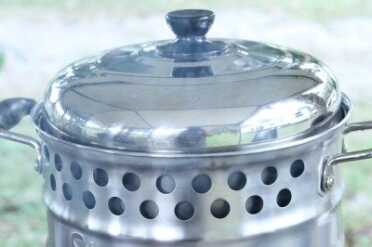
Though I set it up correctly, even the StoveTec pot wouldn’t boil with just that little amount of fuel.
If you use the pot skirt correctly, I think other secret is really to jam the fuel sticks in tight to the sides of the fuel door so that very little air can get past them to the flame. This keeps the fire from reaching a mini-raging inferno. And as you can see, I put a temperature probe into the stovetop oven and measured only 300 degrees. This was with flames licking up visibly from the hole, so though it may look like the fire was burning as hot as possible it wasn’t. The chicken didn’t burn. It was, however, coated with a smokey coating that not everyone would love, and I don’t know if this was due to using the oven for the first time, the type of fuel, or the cooker itself. I can’t recommend this particular stovetop oven for this application due to the bad taste, but we will revisit this in the future. There is a Camp Chef Dutch Oven with a similar cone in the middle that hopefully will work even better than this alumimum oven, and though it is more expensive (I can only find this Swedish product on Ebay right now for over $80 with shipping and for $65 from one US retailer), you are talking about a heavy cast iron Dutch Oven with shelves compared to a flimsy piece of aluminum made for backpacking.
My only warning with the StoveTec is in the way of safety. Obviously you can’t use any burning fuel appliance indoors if it doesn’t have a chimney to vent the carbon monoxide and smoke to the outside. This rocket stove can’t be used inside under any conditions. Also, if you use the fuel pushing method, make sure you don’t leave and that you keep pushing the backs of the sticks into the over. Otherwise the fire will creep out, as you can see in the pictures. The rest of this article is a photo essay on using the stove, so please take a look and read the captions. This is a great product and I already did some homework for you, so don’t let it go to waste. If you are serious about survival, $118 for an appliance that can turn any fuel into a life saving water sterilizer is just a no brainer. I hope you read this article early because they may already be sold out.

Then I realized that they included the fuel ramp for a reason, because if you want to cook with wood, you have to feed in sticks and keep them pushed in from the back.
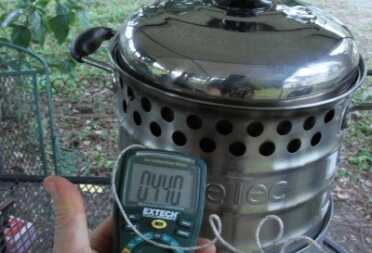
The temperature probe read over 400 degrees in the smoke diffusers once the whole thing was put together properly and working.
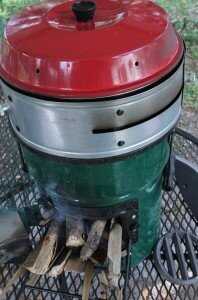
This is how much fuel was left when the chicken went on. I used the pot skirt correctly, though it was difficult because it was hot.
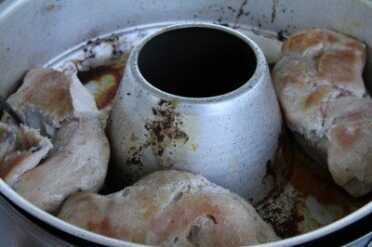
A half hour later, after turning once to see if they were burning, the chicken was done. Overdone actually! And I don’t suggest this oven because there was a not good smoked flavor on the outside of the chicken.
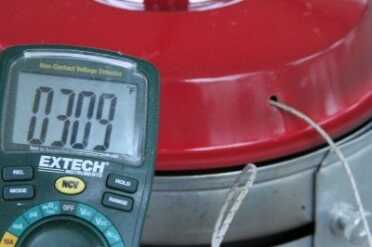
You would think that over an open flame the inside of this stovetop oven would be 500 degrees, but it was only 300, perfect for baking chicken breasts.
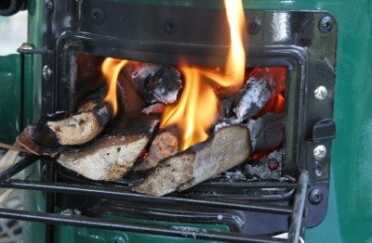
After the chicken there was still this much fuel left, so I jammed it in and closed the fuel door to see how long it would burn. It kept the water pot boiling more than a half hour longer.

This is the oven before I used it. Note the rust because I had left it outside for about a month before testing it, and also note the extra grate they give you for charcoal, which is my next adventure with the StoveTec.
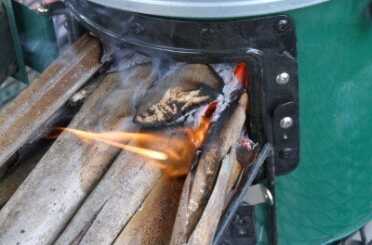
My biggest warning is that besides not using this thing inside, don’t leave it alone for long. If you don’t push the fuel in, eventually the fire will creep out.

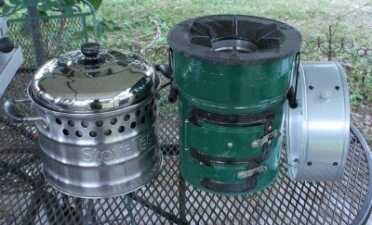
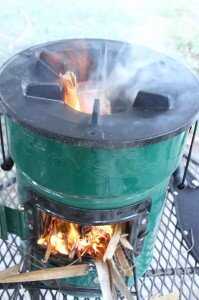

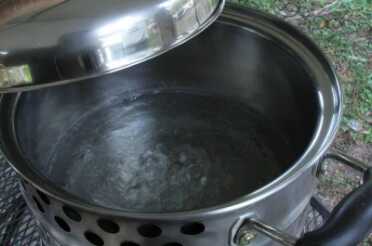


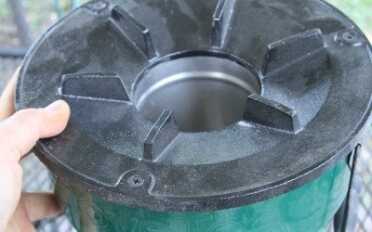
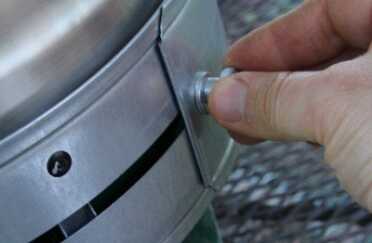
Interesting what most people have to contribute in such a conversation as this, but you can see at a glance those whose common sense is not kicking in when faced with even a minor problem such as the offensive taste of the chicken being prepared over the essence of an open fire. If you give this some basic thought, palm fibers, for the most part, are nothing more than oversize grass plants. I am quite sure that all of us have burned dried grass in a fire at one time or another and I sure would not consider placing anything I wanted to eat in the smoke of burning grass! That will not only taste as bad as it smells, but the smoke is visible for a reason. It is unburned products of the combustion process and could very well be partially a carcinogen which would be harmful to the body no matter how you ingested it. Even the type of wood you burn may be carcinogenic depending on the type of forest ecology in which you have to survive. Black walnut, a fairly common forest wood at one time, has long been known to be a dangerous carcinogen both in its dust (in processing the wood for finished use such as furniture) and its smoke which gives off a toxic smell and a choking clinging after effect if you catch the burning wood down wind.
Of course, all of this is in addition to the very basic premise that there are chemicals and other ingredients which would add to the distasteful flavor of the meat in the finish on the stove and its periphery attachments. We don’t really know what was used in the manufacture of the product or sprayed on it for protection from the elements which has to burn off and get back down to bare steel or whatever the stove is constructed from before you will lose that nasty “burned paint” taste. that’s likely to be a factor in what you were tasting if you failed to light that stove up prior to using it for cooking. You always should give a new product like that a “test drive” before cooking to burn off the paint, oils, and other surface protectants which help to keep the product in salable condition for the customer. Rust doesn’t bother me one bit but there are those who would turn up their noses at a piece of new equipment with even slight surface rust or blemish on it.
Basic problem solving is almost automatic with the seasoned outdoorsman as is reflected in the comments of those here who have made a living or have explored and used the outdoors for their camping and hiking pleasure. You are always solving little problems of one kind or another; how do I hang this kettle over that fire or what can I use to fashion a wind break with whatever is at hand here in the woods. It is part of the experience and the enjoyment of using the outdoors for your own “convenience”. Just ask any green camper who has pitched their tent at the bottom of an incline how that worked for them when the rains started …….. Lessons are everywhere to be learned, we simply have to choose HOW we wish to learn those lessons. There is the easy way, follow the advice of those who have already invented the wheel, or there is the hard way, do it yourself and profit by your own mistakes. Either way, the lesson will be burned into your brain and you become that much more of an “expert” in whatever you are pursuing in your life. I’ve heard that “Higher Education” is learning life’s lessons in performance of a duty by discriminating between the mistakes of others who have preceded you in that same endeavor and studying the successes of those who have chosen to find the most efficient way to do the job.
Found this home made rocket stove.
http://www.diybullseye.com/make-a-rocket-stove-out-of-a-no-10-can-3-soup-cans/7/
On the open cone when you cooked the chicken; you could experiment with covering the cone opening with aluminum foil or tin can maybe; this would allow heating; while reducing exposure to smoke; if you are using an scrap wood source that has an undesirable tasting woodsmoke….
I also agree that wrapping the meat in foil is a good idea when using an undesirable tasting heat source…
if you are interested in a rocket stove check out silverfire.com not knocking this stove but the silver fire seems to be constructed better. alittle more expensive but i believe its worth it. and yes i do have one and love it.
Try the survival rocket stove by Silverfire. Much better stove.
We have contacted them for review product.
Sorry boys, I believe I have spent my share of time out in rough camp, but I just do not see the usefulness of this stove.
Possibly for a backpack stove, but I have seen purpose made fuel cell style backpack stoves that are much, much more efficient and easier to use. Personally, if I’m hauling an armload of wood and am only able to cook a couple chicken filets and heat to boiling what appeared a small amount of water, all outside in an inclement environment, then I will put in the additional effort and set up a real cook fire. While I suspect this tiny stove would be more efficient using lump or briquette charcoal, I still just do not see the utility of it. Now before I receive a deluge of hate filled reply……..give it a rest……everyone is entitled to his or her opinion and I’ve simply stated mine. I’ve cooked on many a cowboy open fire bringing nothing along except a grate and cooked some marvelous meals for several and on whitewater trips seen our guides do remarkable cooking with a cast iron dutch oven and just a few briquettes. This would be just one more expensive gadget to find the storage shelf.
Oh sorry this was written for at least an 8th grade reading level.
Tim, I’m with you – with MANY MANY years of outdoor, rough camping I found that when moving around, or even if in a place for a day or so, an open fire and a few good rocks do the trick very well – The magic about this stove is the SIZE of the wood. It will burn TWIGS – and in the Great Basins and Ranges, that’s about the best you can do. Tough half an hour of gathering bitterbrush and carrying it to camp could get you one meal and morning coffee and maybe a pancake, this would give you more meals out of less wood. But if I was just camping and moving as I’ve had to do many times — an open fire with well placed rocks and a couple of light-weight pans does the trick each and every time – without fail – though in high wind (dangerous) or super cold (need more wood) it gets tiresome. My study areas were 5 miles square each, so I had a base camp where I had the ‘good’ stove, – and would carry my old Soviet multi-burner stove as a good back-up to when it’s snowing or simply too windy to use an open fire safely in the brush of the Itermountain West – And that stove would burn anything from low grade motor oil to gasoline – They are the ones i mentioned that I saw on E-Bay for about $30 bucks or so (today I see the ‘low’ price is $70 – but they come and go – wait and you’ll see them listed around $30-$40, they are the USSR knock off of the old Seva that that the internal fuel tank that rolled out – with the wrench and various sized orifices for the various fuels all stored on chain latched containers so you could lose them only if you YANKED them REALLY hard and broke the chain that held them in place.)
I like the review. Written by a fella who’s not an expert for folks who aren’t experts. Good supporting photos as well. Thanks for the effort Paul.
Todd.
I think the physics explanation is wrong, but then I could be wrong. I believe, assuming this works like other rocket stoves, it doesn’t limit O2, it concentrates the heat, and the fire’s requirement for air creates a superheating fan effect that results in more complete combustion of volatiles in the wood. Normally, these are wasted. Thus, more BTUs/unit of fuel. I suspect it’s more like a forge, which gets a higher heat by forcing air into the mix. Burning wood in a reduced O2 environment, on the other hand, is how you make charcoal. Comments?
Doc Warner is absolutely correct – you increase your BTU (Kilojoules) output by burning the particulate (‘soot’ and ash) content of the smoke that rises. Some people use these to heat their homes by incorporating them into a thermal mass – One video shows a Thermal Mass Heater from near the Canadian border that keeps a house warm using ONE medium armload of wood per DAY! Here’s the link –
https://www.youtube.com/watch?v=4usXIAoy9us
And of course you can move through the videos on the right to see various designs using this method – and many will explain how the ‘vortex’ forms and how it reburns the smoke, then reburns it again giving you a FAR higher efficiency – there are MANY designs using tin cans or welded box iron – some will bring 5 liters (just about 1.25 gallons) of water to a rolling boil in 5-8 minutes. While I was out doing field work for a college degree, I stumbled upon this idea when I decided I wanted to build an oven on my camp-fire so I could bake foods as well as have some ready warm when I came back from my study area (the fire enclosure was inside-outside, dividable by a rock during the winter) and the rocks in the ‘chimney’ warmed up enough that it would radiate heat well into the night – about 2 AM I could get up and put on some more wood when I went out to take a leak, and the shelter (part tent, part scrounged metal roofing and wood that had washed down the river when old mining camps or ‘hunting camps’ would fall into the river (a Sierra River so more like a very large stream in the East) and beach itself. Yes mornings still were cold, but the water in the shelter didn’t have a crust of ice on it, and she’d fire up for that first cup of coffee in the morning quite well with some dry cedar (juniper on the Eastern side of the Sierra)– I didn’t know I was using this basic principal in a primitive form, but now, 40+ years later, I know I was. So even if your ‘mass’ is just a heaped up pile of rocks built around an old single wall stove pipe that had holes in it – it will keep radiating heat once the rocks warm up.
So for individual travel use (tin cans) – or for a more permanent encampment, these things do work – and while you may get a fancy one for $100+, you can build many for well less than $5 and some time and a good pocket tool or swiss army knife.
I suspect that the chicken didn’t taste very good because of the chemicals already mentioned – also slow burning pine can create creosote – a carcinogen – though in a properly built stove this should not be the problem since the creosote would disappear on the reburning of the smoke — the flavor may have been because of chemicals in the stove or chemicals the wood was treated with – as well as the wood itself – In the West we don’t often smoke in Oak, though in the South I hear it’s often done. We also don’t smoke in pine because of the turpentine and other volatiles that can be in the wood – but fruit wood and nearly all hard wood can be used to smoke (cook-preserve) food.
Do check out YouTube if you are interested. It’s an amazing process – I learned a LOT of new things and skills in just one afternoon of looking at the various designs. And they all seemed to work. Just ONE word of warning – just try to stay away from the ones which start out “this is the first time I’ve tried this . . .” – they run FAR too long, but you get to watch people make dumb mistakes if that’s your thing.
Completely correct. The smoke driven off from charcoal generation can be captured and returned to help heat the process. Almost self sustaining. Ditto for creating coke from coal. Makes me wonder about using coal in the stove on the charcoal grates. Would require closed cooking or the food would taste nasty.
There are some home built units on You Tube. I’ve been considering one to heat my garage when I’m doing woodwork out there in the winter, maybe keep a pot of water on for moisture in the air.
Food will have a better being smoked, when you BBQ your meat takes on that smokey flavor this makes it BBQ.
For the record, this was not a pleasant smoked flavor. It was like a residue of a chemical.
Most stoves, pots etc. need to burn once to remove chemicals that remain from manufacture. /this will-may affect flavor
If the wood isn’t burning clean, or the chicken was put in very cold, it could be creosote. This is a common problem for people first learning how to cook with wood. It is important for your flavor that the wood burns properly if the smoke is coming in contact with the food
Just go to youtube and try “home made rocket stove” or “DIY rocket stove” and you will see how to make one from say an empty can of peaches and an empty can of beans. – cost: the price of the cans – and thus in “survival mode”, free (presuming you have eaten the peaches and beans. No need to waste well over $100 on fancy things when I watched a rocket stove from some guy in Britain that was a self-contained cooker, water distiller, complete with dishes and utensils – but it’s large and really doesn’t use the ‘rocket’ technology – see the post below from Doc Warner.
probably a good idea to do a few burns and cure in the stove and get the paint smell to abate, manf could be using a solvent based rust preventative for shipping ?
Good Morning,
I have been camping most of my life and I learned a trick from my Mother that will help with the soot on the cooking utensils issue. My Mother would take liquid dish soap and cover the outside of the pan or pot with the soap with a paper towel. Once the soap was dry, the pot or pan would be used on the stove.
The pan is just washed afterward and the soot comes right off without any problems. I watched this done hundreds of times and I let everyone know of this trick. I do not know why it works so well, I just know that it does.
Oh yes it’s a great way to keep those pots looking good. The aluminum pots are the hardest to clean but with the liquid soap applied prior to cooking over an open camp fire or anything organic makes it oh so easy to clean. I learned this method 50 years ago in the Scouts.
Um wood type very important silly
you send me an email and I want to see that is in the email and I’m told I am not authorized to view this page. What the hell is going on???
Re bad-tasting smoked chicken, I should imagine that the smokey taste would be largely dependent on the fuel source. “Palm branches and sticks” — Yuck. Apple wood, hickory, oak, probably yield a much-nicer “smokey” flavor. Just a thought.
-RDH
Of course your going to get the smoke from the fire all over your food if you use an oven with the open cone in the middle. Either use a frying pan or wrap your chicken in aluminum foil.